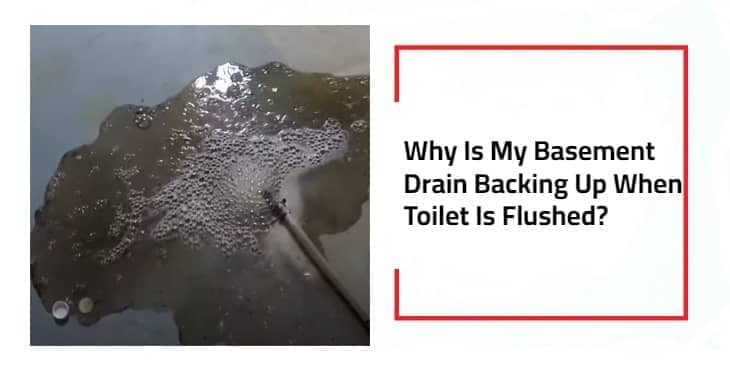Watching your basement drain backing up wastewater is one of those unpleasant situations that no one ever wants to be in. It’s worse when people face it for the first time.
There are various reasons why the basement drain backs up. One of the most common reasons is a clogged or blocked drain line. And one most common reasons behind clogged drain lines is flushing non-flushable items.
Whatever it is, if your basement drain is back flowing when the toilet is flushed, and you don’t know what to do, don’t miss out on this guide.
Because it covers everything that you need to know in order to overcome this issue.
Understand the Inner Workings of Floor Drains
If you can understand how the basement floor drain works, that’ll help you to get rid of the back-flowing problem all by yourself without needing the involvement of professionals.
In order to make it easy for the water to flow in floor drains, they are set at the lowest point of the basements. And floor drains take wastewater from different sources apart from the toilet.
Floor drains take water from dishwashers, sinks, bathrooms, wash basins, washing machines, etc. And then safely moves the wastewater to the city’s main sewer drain line.
Usually, toilet floors, sinks, wash basins, and bathrooms, have metal or plastic gratings that prevent larger particles from getting inside the floor drain.
But if the gratings are not there or broken, they might allow large particles to go through the line, which can cause blockage in the line.
Reasons Behind Basement Drain Back Flowing When Flushing the Toilet
Before we get into how you can get rid of the basement drain back flowing, it’s important to know what causes this issue. It’s because the solution depends on the reason behind it.
Well, there are a bunch of reasons why the basement drain backs up when flushing the toilet, have a look!
Flushing Non-flushable Items
This is the most common reason why the basement floor drains backflows. Most of the materials people flush in the toilet don’t get broken, and regular accumulation of these items entirely clogs the pipes, which causes drain backflow in the basement.
Here are some common Non-flushable items that people keep flushing –
- Wipes – Even though most of the wipes come labeled “Flushable”, they aren’t. Maybe they break down a bit in the water, but they don’t break as well as paper. And flushing them can lead to bad clogging.
- Toilet Papers –There are a few types of toilet paper that don’t break down. Therefore, make sure to only flush those which completely break down.
- Pads, Toilet Towels, and Tampons – When these cause blockage, calling professionals is the only way.
- Unbreakable objects/Hard objects
- Grease and Fat After Cooking
You should not flush medical items or chemical items too. Even though they don’t cause clogs but when mixed into water, they can cause water pollution which can be life-threatening for wildlife.
These are some materials people often flush, which they shouldn’t. The old flushing system wouldn’t have allowed flushing some of these items.
But now, some advanced types of toilet flushing systems have made most things easy to flush.
Our sewage systems are only designed for toilet tissues and human waste, so try your best not to flush anything else other than these.
Blockage in City Sewer Drains
In some cases, the basement floor drain backflow isn’t because you did something wrong. If somehow the city sewer drain becomes clogged, your basement drain might cause backflow.
Not only blockage or clog but the burst of pipe is also a reason behind the drain backup in the basement.
In case you don’t know, there’s a way to keep the basement safe when there is something wrong with the city sewer drains, and that is backwater valves.
If you don’t have them already, you can get a plumber to install these valves.
1. Arbor Roots
I know it may sound weird, but sewage is loaded with nutrients that help trees grow, and if there’s even a tiny hole, tree roots will get through slowly, causing the pipe to burst.
Trees start to grow inside the pipe and start catching all the items that don’t break down, such as toilet towels, wipes, etc. And that results in huge blockage.
2. Broken Drain Line
Though it’s not a very common scenario, if it happens, it’s the worst. Like most things, drain lines also age, and at a point, it breaks, which can also cause backflow in the basement.
The only way to solve this issue is to get the line replaced, which is not only time-consuming but expensive as well.
3. Bellies
You might not have heard of this term. When there are days in the pipe or a portion of the pipe has bent downwards, it is called a belly. The causes of this are earthquakes, soil erosion, poor installation, etc.
Sags in the pipe can create a blockage. And a downward bent pipe will accumulate dirt and debris, which increase in amount day after day, that’ll lead to blockage as well.
4. Rainwater or Flood
When it’s raining heavily, and the entire city is flooded, that can cause your basement drain to backflow. But if you have backwater valves, they’ll save you from the mess.
How to Get Rid of Basement Drain Back Flowing When Toilet Is Flushed?
If you see the basement drain flowing wastewater back upon flushing the toilet, then most probably it’s due to blockage in the pipe. To get rid of this issue, you’ll have to unblock the pipe so that wastewater can go through.
And there are various ways to unblock pipes all by yourself. Check them out –
1. Baking Soda and Vinegar Mixture
Take a good amount of white vinegar and baking soda. Mix them up properly, and then pour the mixture into the toilet. Leave it there for 10 minutes, and then flush the toilet a couple of times.
It’s an old remedy for unblocking pipes, and if the blockage isn’t huge, the mixture unclogs the pipe pretty fast.
2. Hot Water
It’ll only work if you have often flushed grease and fat from the pan after cooking. The fat and grease buildup can cause clogs. However, hot water seems to break the grease and fat buildup.
Boil a good amount of water and then pour it down to the pipe which you think is blocked.
Run the process a couple of times, if the blockage is due to the grease and fat buildup, then hot water should unclog the pipe.
3. Plunger
One of the most inexpensive yet effective ways to unclog pipes is to use a plunger.
Before using a plunger, you’ll have to wear rubber gloves and a plastic coat to cover your body, and a mask to cover the mouth if you want to be safe from wastewater spills.
Place the plunger on the opening of the pipe and gently push it to pump air. Gradually increase the power and make intense pushes to unblock the pipe.
Plungers come in different sizes, so make sure to pick the right size.
4. Drain Snake
Another incredible solution for intense clogging is drain snakes. These are extremely flexible metal cables that can be run through the pipes.
Hold the plastic handle with a hand and then slowly insert the snake’s twisted head through the toilet or pipe. And slowly, keep pushing back and forth until you feel like the blockage is removed.
Frequently Asked Questions
How do I unclog the main drain in my basement?
You can use a drain snake if the blockage is heavy. Or you can call professionals who have specialized tools.
How do I know if my main sewer line is clogged?
If you see water coming back up on the shower when you flush the toilet, then most probably, the main sewer line is clogged. There are some other symptoms as well.
Why do my drains gurgle when I flush the toilet?
It indicates that the pipe is blocked somewhere. Excessive toilet water bubbles are another indicator of a blocked pipe.
How do you snake a basement drain?
You just insert the twisted head of the snake through the pipe and then push it back and forth.
How much does it cost to snake a basement drain?
Plumbers might charge $100 – $270 depending on some factors.
Why does my basement toilet keep clogging?
It could be due to many reasons, but the most common reason is flushing non-flushable items.
Why does my basement toilet bubble when I flush the upstairs toilet?
It’s because of the distance. When water travels through the pipe, it creates air pressure which is why the basement toilet bubbles.
How do you unclog a downstairs toilet?
A plunger or drain snake can be effective options.
What is the best drain cleaner to unclog a toilet?
The Drano Max Gel Clog Remover seems like an effective one if used right.
What do plumbers use to clear drains?
They use different tools, such as plungers and drain snakes. Some professionals even show up with some specialized tools as well.
What chemicals do plumbers use to unclog drains?
Most of the plumbers used Hydrochloric acid, which is also called muriatic acid.
Can you pour Drano down a toilet?
Yes, you can pour Drano down a toilet as long as you pick the one that’s suitable for toilets.
What are the most common basement toilet problems?
Clogged and frozen pipes are pretty common basement toilet problems.
Conclusion
So, if your basement drain backing up wastewater, then the chances are high that it’s due to blockage in the pipe or floor drain.
If you don’t have any experience in unclogging pipes, and you’re not feeling confident about doing it all by yourself, it’s best to hire professionals. They’ll get it done quickly.

